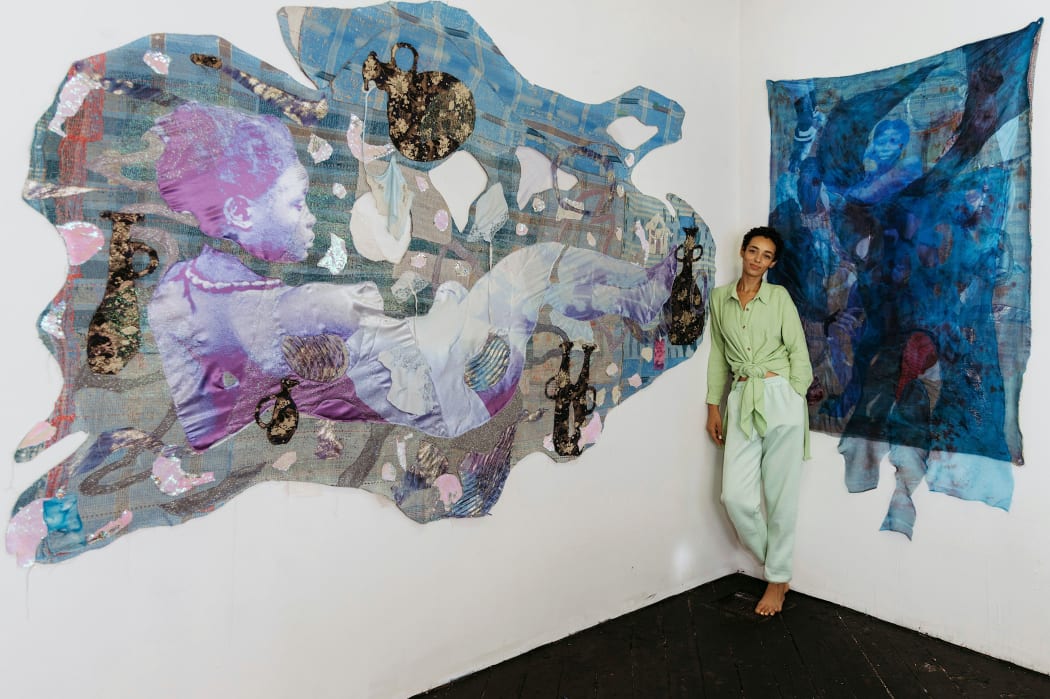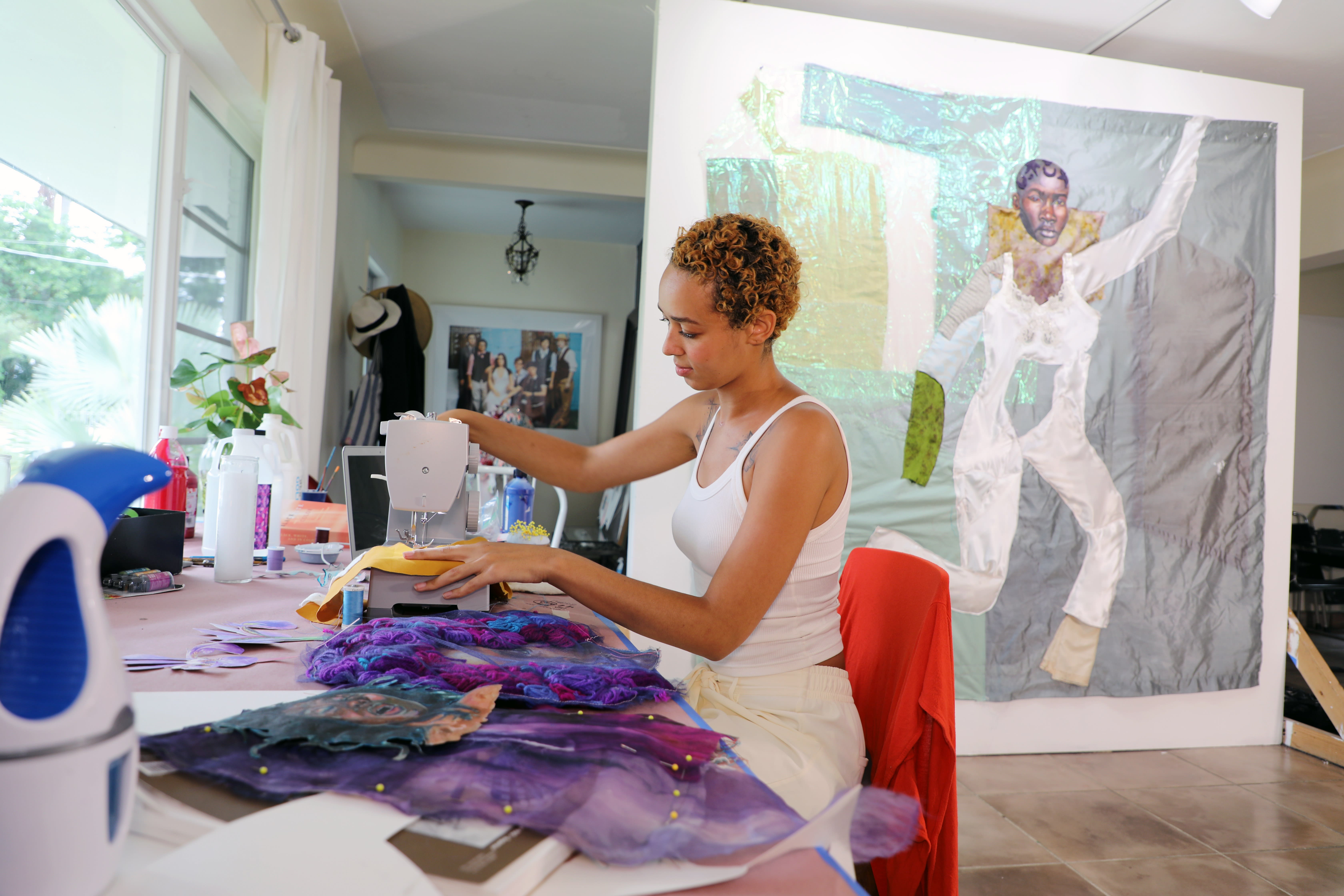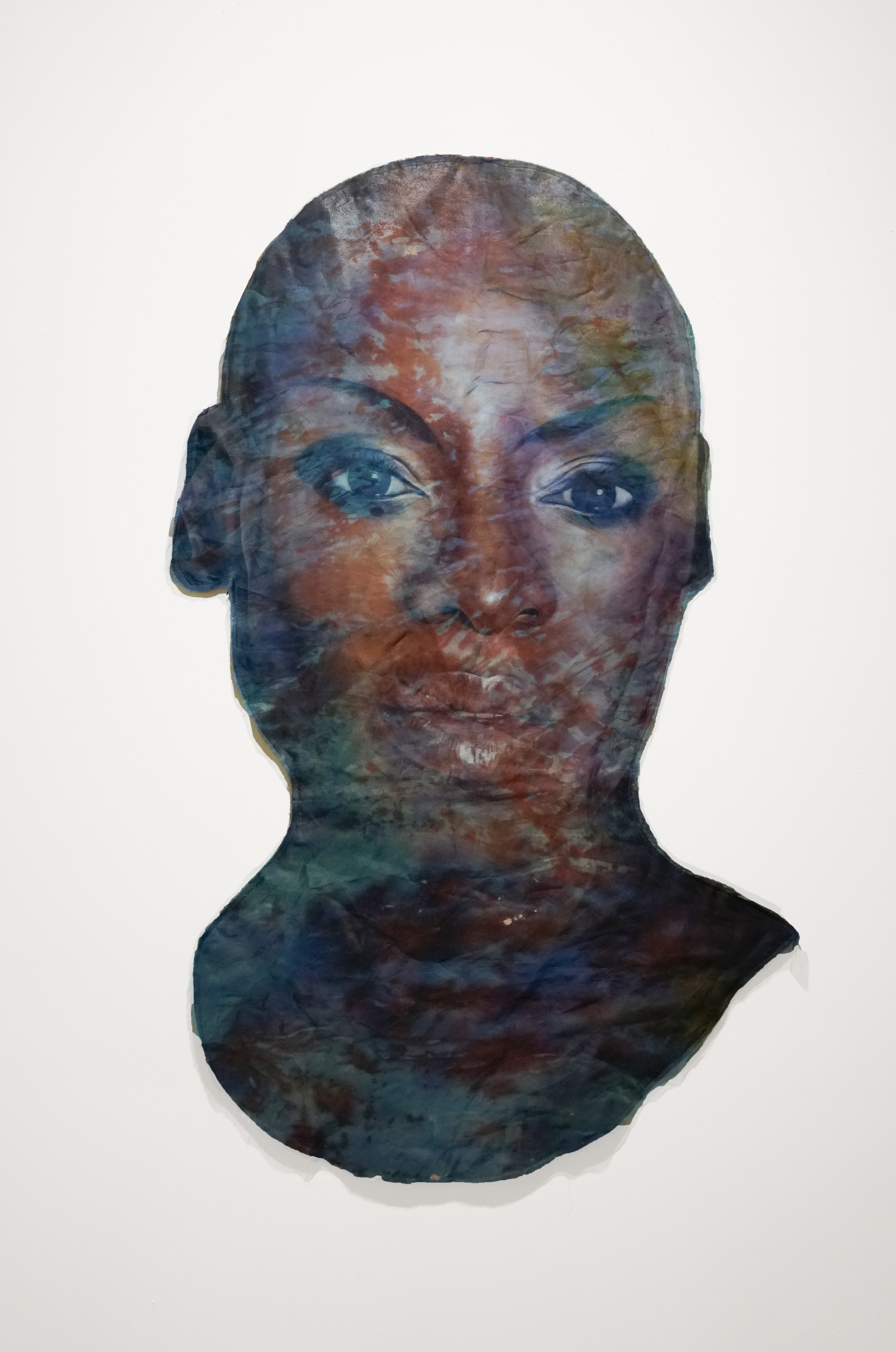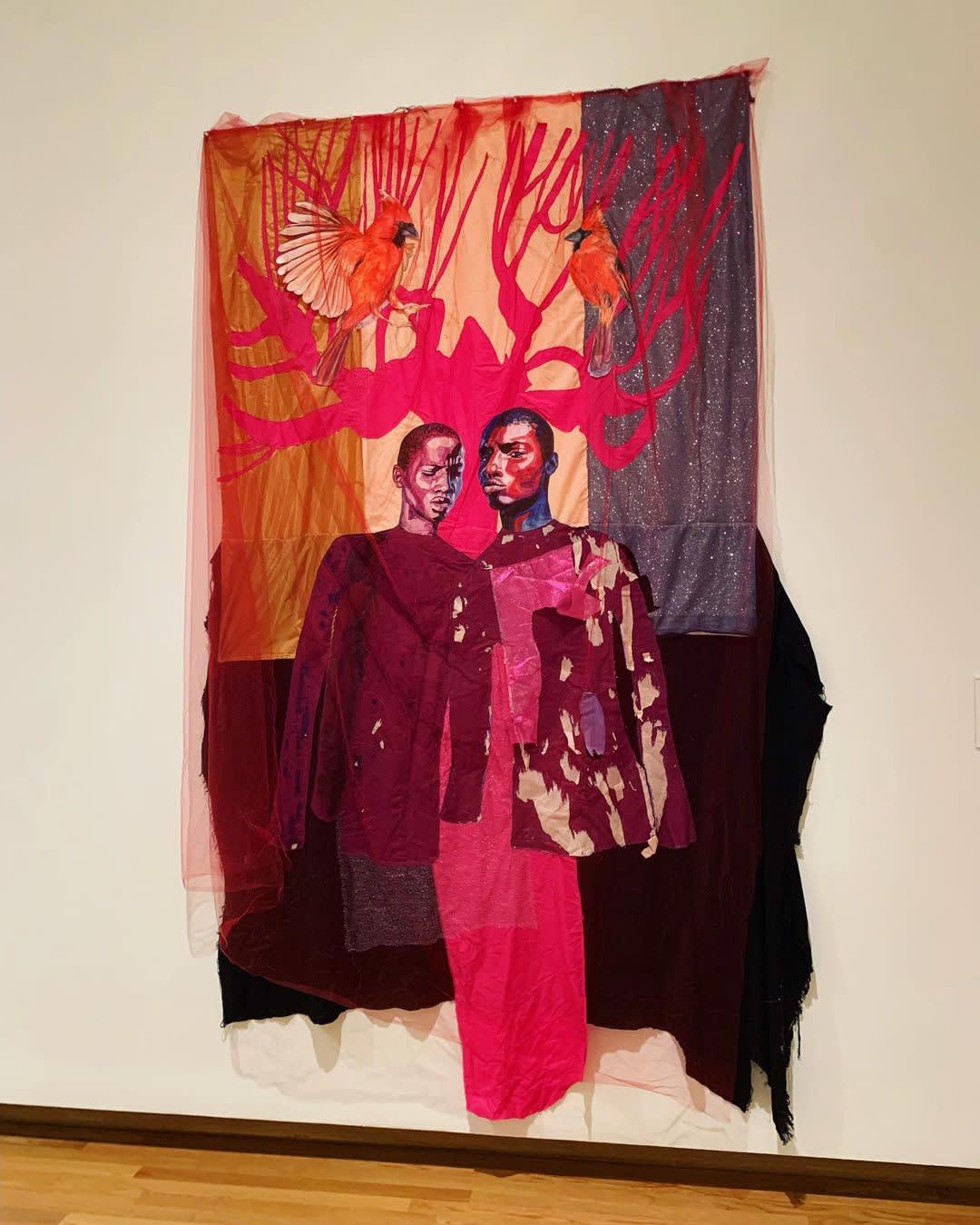
You call yourself “a self-taught painter and seamstress”, but one shouldn’t forget that you have received a brilliant education graduating from Yale College. To what extent does your academic background influence the way you interact with art as well as the very process of creating?
When I was a kid, a couple of my mom’s friends were painters and they kind of guided me. And then when it came to sewing and really figuring out painting and drawing – it was just me spending a lot of time by myself, just doing it. But then when I got to Yale, I was exposed to this class on 20th century African American poetry, and I was taught by Elizabeth Alexander who is an amazing poet. I feel so blessed to have caught her while she was there. That class led me to do African American Studies for my Bachelor’s degree. I had never been exposed to art the way that I was in that program – specifically with Professor Alexander – but also with other professors. Just the way that they approach arts and culture in general. We would analyze poetry, music videos, and fine art like Lorna Simpson – we were looking at this whole array of Black culture. I had never looked at art in that way before. Observing all these modes of creation – it was like tapping into a new language. That was awesome!
Then I spent six months in London, studying abroad at Central Saint Martins College of Art and Design and that also really expanded the way that I think about art, because they are very process-oriented and experimental. So, they would push us to always document the process and then to share it with each other when we were talking about our work. I think it pushed me to experiment more and to think about art beyond just the art object. I was enrolled in the Visual Arts course Saint Martins and it was very exciting because I did not actually have any classes. There was a small cohort of us, and we went to museums and galleries every day. We were taking in all these artists and artwork, talking about it and then we would go to the studio and make our own work. So, it was all about absorbing art and having these deep conversations about the meaning of things and materials. I think that combined with the Black Studies program has expanded the horizons of my practice.
You work with textiles, to be more precise with silk, satin, velvet, and even hand-dyed organza. How did you come up with this idea? Did you use to sew when you were little? Could you please describe your artistic path?
When I was a kid, I had a dream: I wanted to be either a fashion designer or an interior designer. I was really excited about textures, space, and the environments we live in, and the textures and the colors that we surround ourselves with. And I would even try to make clothes. And some of them were actually pretty good. I didn’t like making clothes because it is very technical, for example the patternmaking process. There were always a lot of technical aspects that I did not know how to do, and I don’t like to follow rules when I’m being creative. I think this allowed me to flourish in being an artist, because I can still work with fabric and sewing and do all the things that I love, but I can make my own rules. In high school I was really focused on painting. But then when I went to London and was painting again, there was something about it where I felt stuck, I tried to remember what brought me joy and passion as a kid, and that is what made me bring sewing back into my work.

© Ambrose Murray at Fountainhead Residency. Image: Alex Nuñez
Do you have your favorite textile that you prefer to use for your artworks?
Silk is my favorite. And there are so many types of silk, like charmeuse and organza and they all are so different! Some are translucent, some are opaque, and then you can dye them… I love silk! When I am working in my art studio, there is fabric all over the floor. On the walls, on the floor – it is everywhere. I am now trying to figure out how to store it, because it is hard to store fabric. When you just fold it up you cannot see it, and it is useful to be able to see everything that you have. So, I am still figuring out how to organize it.
In your works abstract elements are intertwined with figurative ones. Could you please tell us about the protagonists of your art? Who are the figures that you incorporate into your works?
Usually, my process starts with a photograph. One of my first loves was collage. I used to take magazines and make collages out of them. So, that is how much of my work starts – looking through photographs. A lot of what I have accessible to me are photographs online – and that is where I often find my subjects to paint. But then recently I have been looking towards archival photographs. That is what I have always been interested in, but now I actually bring historical photographs into my work. The last solo show that I had (editor’s note: “Within Listening Distance of the Sea...”, Fridman Gallery, New York, US) was all about archival photographs; and a lot of them came from colonial postcards. It goes back to my work in African American Studies – thinking about the archive and what it means, analyzing the “holes” and the missing stories left out of the archive. I feel it is the job of artists and scholars to imagine, create and even invent stories that have been lost to history as a form of collective healing and repair.

© Ambrose Murray, Misty Blues I, 2021, Oil on fabric, hand-dyed silk organza, backed with vintage kantha quilt, 121.9 x 78.7 cm / 48 x 31 in. Image: Ambrose Murray
What is your intention behind bringing the stories from the past into the present?
The history of lots of these photos is outside of the frame of the photograph itself. There are so many power dynamics of violence and colonialism, and sexual coercion. A great number of these photographs are nude – women and girls in Africa or in the Middle East, or sometimes in Asia. For me, it is a way of having a conversation about the story beyond the frame of the photograph.
There is also a book by Lisa Lowe The Intimacies of Four Continents where she theorizes about the interconnectedness of Asia, Africa, the Americas and Europe and how colonial power has been structured amongst and in-between these communities in the Atlantic World Most often stories of these different communities and histories are so separated from each other when in reality our histories and present are so interwoven they are impossible to separate. You can see that when you look through and find all these postcards – postcards of naked girls and women from East Asia, West Africa, North Africa, from the Middle East, from India. These images reveal how colonial violence and coercion were happening in every corner of the world and impacting women and girls across every continent. In some way, these histories may connect us all.
Have you ever tried to explore your own family past and present it in art?
I am so glad you have asked that. The archival photographs are a way for me to keep myself more distanced from the work. I almost see the figures of my stories like long-lost sisters or cousins, or as if they were my ancestors. Recently I have been thinking about looking at my own family photos and trying to consider the relationship of my family stories to these histories. I believe it is a lot harder to work with your family’s past. And then the idea of putting images of my family in the gallery to sell them – is also hard for me to figure out. So there are a lot of dynamics to consider. But I have been thinking about working with my family photos and have started to do it, but it is scary. Working with archival photos is important of course but working with your own family – there is so much more that could be revealed.
Violet, purple and blue are dominant colors, threading through your works. Could you please explain to us, what is the reason and motivation behind this choice and what does it reveal about your art?
Blue has always been my favorite color. I feel it has the capacity to hold so many meanings and stories – starting from water to memory, emotions, the sky. There is so much depth in blue. I think I have used blue a lot because there are a lot of images around water in my work. Also, water is such a strong symbol for memory because water has its own memory, and it is like a messenger. I want my work to evoke feelings of water, even if it is not through blues, but through the movements of the fabric itself.
And then violet. My favorite book is The Color Purple by Alice Walker. She talks about the color purple, and it is very much a story about spirituality, about queer love, survival and self-making. at the end of the book Celie, the main character, is sewing all the time – it is her way of reclaiming herself, reclaiming her autonomy. And she becomes known for sewing pants, which is a strong message that she is sewing pants after pants after pants as opposed to dresses for example. Beyond The Color Purple, violet also has a spiritual meaning. Purple is considered as a color that connects us to God or to spirits, “the violet light” or la luz violeta. It is a tool for prayer and healing, and a color I often use in my work.

© Ambrose Murray. Image: Celeste Burns
Your technique is truly amazing, and I believe there is incredible time and effort you invest in it. Could we probably speak about the practical technical aspects? How does the process behind looks like, leading to such exquisitely crafted textile works?
It is hard for me to say how much time a piece takes, because I have to create each part of the work. Instead of using paints like a painter, I have to source each of the colors and each of the textures, and each of the images. Sometimes I go to the fabric store or use found fabrics from the thrift store. I also have images printed on fabric. There is the process of finding the photograph. Sometimes I edit it and manipulate the colors of the photo on photoshop before printing them. And then there is the process of dying the fabrics – different layers of the process happen at different times. And then when it is time to make the piece, I pull together all these different elements that I have collected over time to create the artwork itself.
Do you use sketches or rather work with textiles from the very beginning?
I keep most of it in my head. The process usually starts with a photo printed on fabric or with a figure. I create a story around that figure, finding the textures or colors that I already have around me in the studio. Sometimes I sketch out the potential shapes or cut outs for a larger work. I like to make work that is not square – that are different or oblong shapes, almost like puddles of water or cowhides – so sometimes I need to sketch it out before cutting out the shape.
I have read that many images that inspire you come to you in your dreams or daydreams. May I ask you to tell us a bit more about this daydreaming practice helping you to find inspiration?
The last piece that I have posted on Instagram – currently on view in Durham, North Carolina (editor's note: at The Nasher Museum) – that piece has two big red cardinals in it. For a while, cardinals felt little like spiritual messengers to me. I would be driving, or I would be on a walk, or I would be in the yard, and when I was thinking about something specific, I would see a cardinal. They came like little messages, saying “You are on the right path”. And I also had this dream, where I was not myself, but somebody else. I was sitting at a little dining table in the kitchen. And there was a big window and a tree out of the window. And these huge red cardinals were sitting in the tree. And I just thought: “Oh my God, I have to paint this!” So that is what made me make that piece.

© Ambrose Murray's Instagram, The Space Between, 2020. Image: Ambrose Murray
But then for the daydreaming – I feel like sometimes I see images in my dreams and then I will keep thinking about them during the day. And maybe it will grow and expand as I keep thinking about it. Daydreaming and imagination feel like such important tools for our survival. I think that daydreaming has always been a tool for me to imagine the future that I do want. So, it is just like going into your own internal world and letting it come out.
Referring to your art practice you have once mentioned “the thin veil that exists between the spirit world and the physical world”. Do you consider your art to be a kind of a bridge, connecting these two realms?
When I am working in the studio, I feel like I am entering this zone. Then, when the work is finished – well it is usually not finished by then – but when I have an idea of a piece and I need to work on it, it is almost like – “Oh wow, did I do that?“ I almost don’t feel like I made it. I feel like a messenger or a channel, I don’t know if the work itself is the veil or the bridge between these spiritual and physical worlds. I think it could be. But I almost feel like the process is – the process of making. And then hopefully when people are in relationships to the work, then the experience of the work could also turn into that bridge.
Let’s get back to your recent solo exhibition “Within Listening Distance of the Sea...” presented by Fridman Gallery in New York. What are the key topics you were you addressing with the artworks featured at the show?
For that show I was thinking about archival photographs. Like I was saying, I imagine a lot of the figures like sisters or aunts or cousins. And it was almost like each piece was an altar for them, to honor them. here is a lot of imagery that feels mystical, like mermaids or fairies. I think if we follow those stories, they can help us reconnect with the Earth, or the environment, or those stories, that have been lost.
And now let’s throw a glance at the future. What is the most extraordinary project, you would like to bring into life one day?
I think the goal of my work is healing and providing a space for people to connect to their ancestors, but also themselves. In the future, I would love to open a retreat and residency space in nature, focused on both wellness and art for People of Color. A place for healing, wellness, spirituality, philosophical conversations, a library, and much more. There are healing spaces and wellness spaces, but I would like to bring them together in an integrated way.
Interview conducted by Valentina Plotnikova